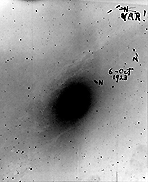
First determination that spiral "nebulae" are external galaxies.
| Physics 321 |
|
Prof. Dale E. Gary
NJIT |
Pulsating and Variable Stars
Naming Variable Stars
Some examples, R Monocerotis, T Tauri, RR Lyrae, UV Ceti, AG Pegasi, BF Cygni, V378 Orionis, V999 Sagitarii. Up to 1925, novae were given a name consisting of constellation and year, but after 1925 they are given variable names. (Why?) Thus, RR Pic and DQ Her are examples of nova names. Finally, a few variable stars are bright enough to have been given greek-letter or proper names, e.g. b Lyrae, Algol, Mira, d Cephei (well-known prototypes).R - Z RR, RS, ..., RZ, SS, ST, ..., ZZ First three give 334 names AA, AB, ..., AZ, BB, BC, ..., QZ V335, V336, ...
Some variable star light-curves (from the Hipparchos web pages)
A
Good Place to Read About Variable Stars
Pulsating Stars
The most important (i.e. useful) stars are Cepheid variables, named for prototype d Cephei. They show regular, periodic brightness changes, and spectral changes.
The spectral changes show
that the surface temperature and radius changes. The spectral lines
also show doppler shifts, from which we can measure radial velocity changes--actually
measure the star's outer layers expand and contract. Cepheids and
other variables (RR Lyra stars are another important type) lie in a particular
region in HR diagram. As low mass stars (0.5 to 0.7 Msun)
evolve and cross through this region, they become RR Lyrae variables.
As high mass stars (3-18 Msun) cross
it, they become Cepheid variables. Properties:
| RR Lyrae | Cepheid |
| mass 0.5 - 0.7 Msun . | mass 3-18 Msun . |
| Pop II | Pop I |
| Core He burning | Core He burning |
Cause of pulsations--lack of hydrostatic equilibrium beneath surface. Here is the cycle:
Table of Classes of Pulsating
Variable Stars
(from Zeilik & Gregory--Intoductory Astronomy & Astrophysics)
|
|
|
|
Class |
Period Range |
Period |
|
Cepheids |
|
|
|
|
|
|
Cepheids |
|
|
|
|
|
|
|
|
|
|
|
|
|
variables |
(Mira) |
|
|
|
|
|
|
|
|
|
|
|
|
Majoris stars |
Majoris |
|
|
|
|
|
variables |
|
|
|
|
|
|
|
|
|
|
|
|
Period-Luminosity Relationship
Why is any of this useful? The period of this cycle, from 1 to 50 days for Cepheids, is very precisely related to the luminosity (or absolute magnitude) of the star. For Pop I Cepheids (the kind in the disk of our galaxy)
MV = -2.76(log P - 1.0) - 4.16Thus, by careful measurement of the period, any Cepheid's absolute magnitude, and hence its distance, can be measured. Cepheid variables are a major link in the distance scale! Problems: Cepheids are rare, and none are nearby. Before Hipparchos, not a single one could be determined using trigonometric parallax.
Population II Cepheids
The Population I Cepheids that we just discussed are stars with relatively high metallicity (like our Sun) and so are "second generation" stars. Stars in globular clusters are low-metallicity "first generation" stars, and since the composition is different, the period-luminosity relation is also slightly different. These so-called Population II Cepheids are about 4 times less luminous than Population I Cepheids.
Measuring the distance to a nearby galaxy.

First
determination that spiral "nebulae" are external galaxies.
RR
Lyrae Variables
Another important type of
variable is RR Lyrae stars. Their period-luminosity relationship
is even simpler--they all have L ~ 100 Lsun,
(that is, MV = 0.5 = constant)
regardless of period. They are fainter, and they are Pop II--important
for globular clusters, but cannot be seen in external galaxies. They
have relatively short periods of 1.5 - 2.4 h
Mira
Variables
Large, irregular variations
in brightness, due to cool (2000 K) atmosphere veiled by dust and molecules
(absorption bands). Locally higher T dissociates the molecules
and allows great increases in L. Periods are P ~ 100
to 700 days, and stars fall in HR diagram where He-shell burning is taking
place. The exact mechanism is unknown.
Nonpulsating Variables
There are several other types of nonpulsating variables:
Several types of stars show mass outflow. This outflow, coupled with stellar rotation in some cases, causes distinct spectral features due to doppler shifts. P-Cygni profile.
Cataclysmic Variable Stars
Table of Classes of Cataclysmic
Variable Stars
(from Zeilik & Gregory--Intoductory Astronomy & Astrophysics)
|
|
|
|
|
|
Outburst (J) |
|
per Cycle (Mo) |
Ejection (km/s) |
Star (Mo) |
|
|
|
|
|
|
|
|
|
||
|
|
|
|
|
|
|
|
|||
|
|
|
Nova Per |
|
|
|
|
|
|
|
|
|
|
|
|
|
|
||||
|
|
|
|
|
|
|
|
|
|
|
|
|
SS Cyg |
|
|
|
|
|
|
We will talk about novae
and supernovae next time, in connection with close binary systems.
Some links to web pages that describe or give examples of these objects
are below.